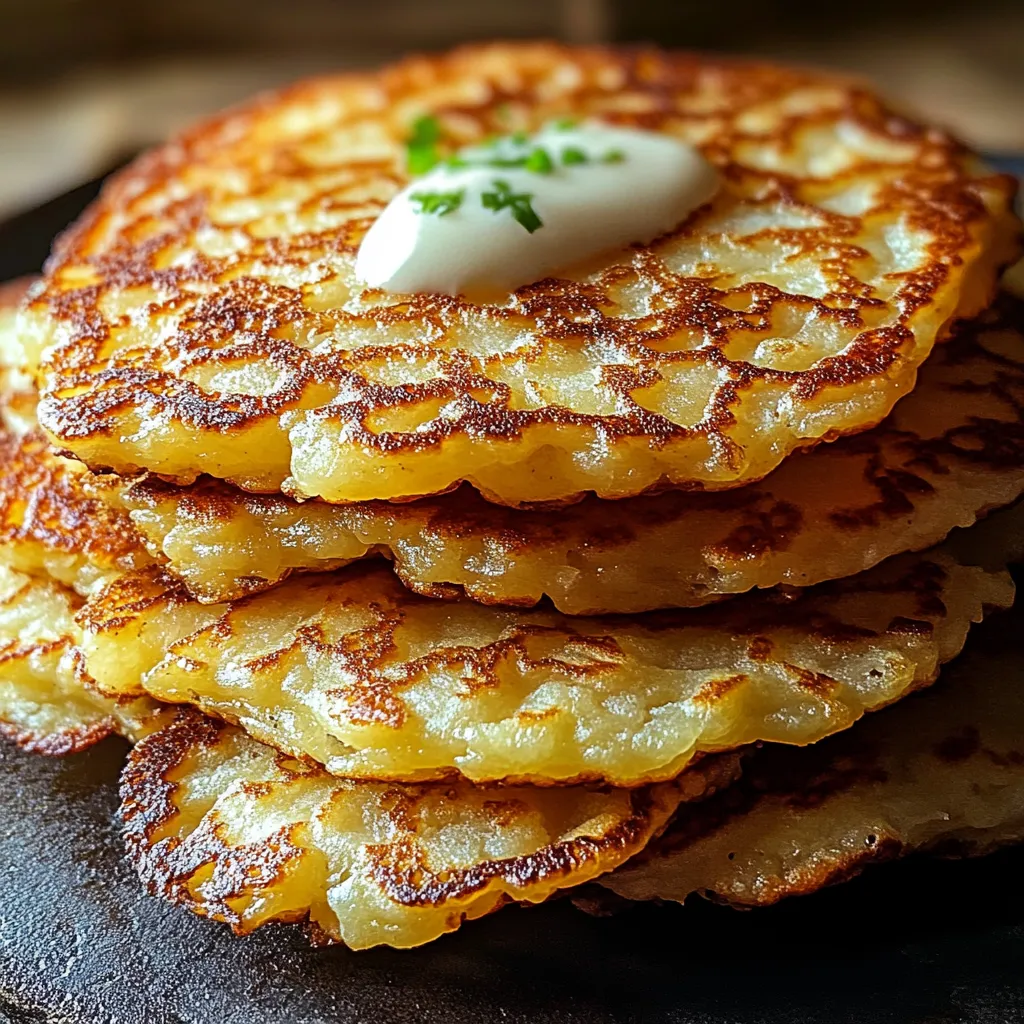 Pin
Pin
This crispy German potato pancake recipe transforms humble potatoes into golden, savory discs that balance perfectly between crisp exteriors and tender centers. My grandmother taught me this traditional Kartoffelpuffer technique when I was just eight years old, and it remains one of my most treasured culinary inheritances.
I first made these potato pancakes during a snowy weekend visit to my German relatives. Watching my Oma effortlessly transform a pile of potatoes into these golden delights ignited my love for cooking that continues today. The smell of these pancakes frying instantly transports me back to her cozy kitchen.
Ingredients
- Russet potatoes: Provide the perfect starch content for crispy pancakes without falling apart
- Medium onion: Adds essential savory depth that balances the natural sweetness of the potatoes
- Large eggs: Bind everything together while adding richness
- All purpose flour: Helps absorb moisture and creates structure
- Salt: Enhances all flavors and is non negotiable for proper seasoning
- Black pepper: Adds subtle warmth that complements the potatoes beautifully
- Ground nutmeg: Brings a traditional German flavor note that elevates the entire dish
- Vegetable oil: With a high smoke point ensures proper frying temperature
- Applesauce or sour cream: For serving creates the perfect sweet or tangy complement
Step-by-Step Instructions
- Prepare the Potatoes:
- Peeling and grating potatoes might seem straightforward but technique matters greatly here. Use the large holes of your box grater for ideal texture, or if using a food processor, pulse carefully to avoid turning the potatoes into a watery mess. The most crucial step follows placing the grated potatoes in a clean kitchen towel and squeezing with significant pressure until barely any moisture remains. This prevents soggy pancakes and ensures that perfect crisp exterior.
- Combine the Ingredients:
- In a large mixing bowl, combine your squeezed potato shreds with grated onion, making sure to distribute evenly throughout. Add beaten eggs, which provide essential binding properties, followed by flour, salt, pepper and nutmeg. Mix thoroughly but gently until all ingredients are fully incorporated without overworking the mixture. You want everything uniformly distributed without making the potatoes release more moisture.
- Form the Pancakes:
- Heat your oil in a heavy skillet until it shimmers but does not smoke. Test readiness with a small piece of potato mixture which should sizzle immediately upon contact. Use a measuring cup to portion approximately 1/4 cup of mixture per pancake, carefully dropping into the hot oil. Immediately flatten with a spatula to about 1/4 inch thickness, creating more surface area for that desirable crispness.
- Fry the Pancakes:
- Monitor heat carefully throughout cooking process as temperature control is essential. Too hot and pancakes will burn before cooking through, too cool and they will absorb excess oil and remain soggy. Each pancake requires 3 to 4 minutes per side, achieving that perfect golden brown color that indicates proper caramelization. Resist the urge to flip repeatedly which disrupts the formation of the crispy crust.
- Serve:
- Transfer finished pancakes to paper towel lined plates to absorb excess oil, then serve immediately while still hot and crispy. Traditional accompaniments include applesauce for a sweet contrast or sour cream for tangy richness. A sprinkle of fresh chives adds color and a mild onion flavor that complements the pancakes beautifully.
The nutmeg in this recipe might seem unusual if you associate it only with sweet dishes, but this warming spice has been used in German potato dishes for generations. My grandmother insisted that the secret to perfect Kartoffelpuffer was adding just enough nutmeg to create depth without overwhelming the potato flavor. One winter evening, she confided that during post war rationing, these potato pancakes sustained her family when other foods were scarce, making them not just delicious but historically significant.
Perfect Pairings
These versatile pancakes shine alongside various companions. For breakfast, serve with fried eggs and bacon for a hearty start. At lunch, they complement a simple green salad dressed with vinaigrette. For dinner, pair with bratwurst and sauerkraut for an authentic German feast. Even the leftovers transform beautifully into a base for eggs Benedict the next morning, with the pancakes replacing English muffins.
Storage and Reheating
Properly stored in an airtight container, these pancakes remain good refrigerated for up to three days. For best results when reheating, avoid the microwave which creates sogginess. Instead, place them on a baking sheet in a 350°F oven for 8 minutes until heated through and crisp again. Alternatively, a quick reheat in a dry skillet over medium heat restores much of their original texture.
Historical Significance
Kartoffelpuffer holds an important place in German culinary history, especially during challenging economic times when potatoes provided affordable sustenance. These pancakes appear at Christmas markets throughout Germany, where they are served hot in paper cones with applesauce. Regional variations exist throughout the country, with some areas adding apples to the batter or serving with lingonberry jam instead of applesauce.
Recipe Questions & Answers
- → How do I ensure the pancakes are crispy?
Squeeze out as much water as possible from the grated potatoes before mixing the ingredients.
- → What can I serve these pancakes with?
They are traditionally served with applesauce or sour cream and can be garnished with chives if desired.
- → Can I make them gluten-free?
Yes, simply substitute all-purpose flour with gluten-free flour or potato starch.
- → How should I store leftovers?
Store them in an airtight container in the fridge for up to three days and reheat in a skillet or oven for the best texture.
- → Can I add extra ingredients for variation?
Absolutely! You can mix in chopped parsley, shredded cheese, or a hint of your preferred spices for added flavor.